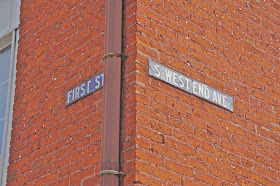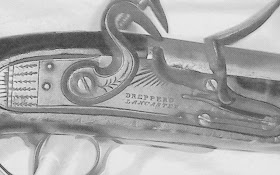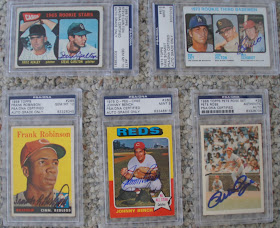It was an ordinary day. Walking out to put some envelopes in the mailbox when I heard it. A loud whoosh and then a hissing sound. Looked up in the sky and there behind the dentist's office across from the my driveway was a hot air balloon. Heard the hiss of the burners and saw the flame as the pilot tried to gain some altitude. Turned around and headed into the house to get my camera for a couple of shots.
By the time I had returned the balloon was much higher in the sky and headed southwest across Lancaster. This morning I opened the newspaper and on page 3, the local page, was a photo of a hot air basket with its balloon in the distance. Seems the wind had been causing problems for the balloon and when the wind shifted later in its flight, it went down in nearby Lancaster Township. Actually it was two balloons that had been traveling together and both had to make landings in a non-routine location. The two balloons landed about two city blocks away from each other, neither with any problems. They did graze the tops of the trees in the area in order to slow them so they could land in open areas away from homes. The newspaper reported that the "chase teams" of each balloon loaded the balloons into their trailers and left shortly after they had landed. I remember years ago being in a hot air balloon and going through the same thing. My wife had bought me a balloon ride for my birthday and a few weeks later I was in the air to the north of Lancaster. Traveled over farmland with three other riders until the wind picked up and caused the balloon to head off course. The pilot managed to control the balloon and descended onto a county road. Spooked a horse pulling an amish buggy as we touched down. The pilot tried to get the balloon under control, but it was pulled down the road as the balloon dropped. We hit a ridge along the side of the road and the balloon tipped over. Myself and the other passengers fell on top of the pilot who took the brunt of the abrupt stop. The pilot was the only one with any scraps and we all hopped in the chase van and headed back to our take-off spot. Neat experience which I never had enough nerve to try again. The balloon is always at the mercy of the environment and at times it does create problems. Luckily the two balloons that landed prematurely yesterday didn't have disastrous results. It was another extraordinary day in the life of an ordinary guy.
Wednesday, September 30, 2015
Tuesday, September 29, 2015
The "Landis Valley Village & Farm Museum: The Conestoga Wagon" Story
It was an ordinary day. Taking photographs of the lazy-board that's on the side of the Conestoga Wagon that's sitting in front of me in the farm machinery and tool barn located in the Landis Valley Village & Farm Museum in Lancaster County, Pennsylvania. The Conestoga Wagon was a farm wagon that came into existence as early as 1717 and was adapted for use on the rough, hilly terrain of Lancaster.
It was about 18 feet long and pulled by teams of specially bred horses known as Conestoga horses. The wagon's body had an upward curve on the ends to prevent the cargo from shifting. It was made from a variety of woods which were cut and dried or cured for three or four years to make the wood harder and more rugged.
The large rear wheels were ideal for crossing creeks and rolling over large rocks while the smaller front wheels made turning easier. Conestoga Wagons had no seats. The driver walked along the left side, rode the horse closest to the wagon on the left side or sat on the lazy-board which was also on the left side of the wagon. He controlled the team of horses with a single long "jerk line" running to the lead horse at the left front. It has been said that the reason we drive on the right side of the road in the United States is due to the Conestoga Wagon navigating the roads in early America on the right side of the road. The cargo might be anything from barrels of grain or flour to cured meats to kegs of whiskey or cider to tanned animal skins or lumber. Wooden bows supplied the support for the canvas cloth top of the wagon. The front and rear of the wagon had bows that were flared away from the wagon at the top to keep the weather from reaching the cargo.
The wagon's wheels were made from the hardest woods by a wheelwright. The outer rim of the wheel, as well as some of the hub was made from iron and forged on an anvil. Wagons might weigh about 10,000 pounds when empty.
When going down inclines a chain on the back wheel, called a wheel lock chain, could be used to stop the wheel from turning thus causing it to slide and slow the wagon. The driver of the wagon was known as the "teamster." The teamster's saddle, if he were riding the left-rear horse, had long heavy leather skirts to keep road grit from getting against the horse. Each of the 6 Conestoga Wagon horses usually wore a rack of bells that warned other traffic of their approach. During much of the eighteenth century it was common for 100 or more Conestoga wagons a day to pass through Lancaster on what what known at the time as King's highway.
Thus the town was always alive with the sound of ringing bells and the smell of horse manure. The journey from Lancaster to Philadel- phia with a loaded wagon would take about four days traveling at 15 miles a day. Muddy roads would slow the wagon while frozen winter roads increased the speed of the wagon. By the 1830's the Conestoga wagon began to lose its place in history for moving goods when cheaper ways such as canals and railroads came into use. Lancaster county can always lay claim to being one of the main manufacturers of the Conestoga wagon and the wagon I'm standing in front of is a fine example of the craftsmanship of the Pennsylvania Germans who lived in Lancaster in the mid-1700's to mid-1800's. It was another extraordinary day in the life of an ordinary guy.
 |
| Here you can see two places that the driver can sit to drive the Conestoga wagon. One is on the lazy board on the side of the wagon while the other is on the rear-left side horse. |
 |
| The Conestoga wagon which is on display at Landis Valley Village & Farm Museum. |
 |
| Another photo of a Conestoga wagon. Notice the bells on the horses which help warn others that the wagon was coming. |
 |
| USA Postage stamp showing the Conestoga wagon. |
 |
| Another Conestoga wagon on display at the Bird-In-Hand Farmer's Market in Lancaster County. Here you can see clearly the 8 wooden bows that support the canvas top. |
Monday, September 28, 2015
The "Head Honcho For The Day" Story
It was an ordinary day. Just realized that I missed one of the most historical days in the history of the city in which I live. Yesterday was the 238th anniversary of Lancaster, PA being the Capital of the United States - if only for a day. It was in the late summer of 1777 when the British advanced on Philadelphia. With General Washington being defeated at the Battle of Brandywine on September 11, 1777, the Continental Congress evacuated Philadelphia. The delegates fled westward and eventually regrouped in Lancaster, the next largest town to the west.
On September 19, 1777 they fled Philadelphia and headed by a round-about route to Lancaster which included stops in Trenton, Easton, Bethlehem and Reading arriving on the 27th. They took the Liberty Bell with them, but a wagon break-down forced them to leave it along the way, and it was hidden in an Allentown church until the British threat to Philadelphia was ended. People such as John Hancock, Samuel Adams, Richard Henry Lee and Charles Carroll assembled with the Congress to conduct business. After their meeting on that historic Saturday they decided to move once again across the broad Susquehanna River to York, Pennsylvania which became the next capital of our nation until July or 1778. Other capitals of our nation have been (1) Philadelphia, PA, (2) Baltimore, MD, (3) York, PA, (4) Princeton, NJ, (5) Annapolis, MD, (6) Trenton, NJ, (7) New York City, NY , (8) Washington, D.C. Kinda disappointed that my hometown was only capital for a day, buy hey, how many cities in the country can claim they were capital of the United States of America, even for just a day! It was another extraordinary day in the life of an ordinary guy.
 |
| The Lancaster, PA Courthouse by Charles X. Carlson. |
Sunday, September 27, 2015
The "Sweet Treats Abound in Lancaster" Story
 |
C. Emlen Urban's design for
the Keppel's Candy Company.
|
 |
| The chute can be seen towering above Keppels. |
 |
| Keppels Inc. was located at 323-325 North Queen St. |
 |
| The Greek and Roman architecture can be seen in this photo. |
Saturday, September 26, 2015
The "A Drawer Full Of Memories" Story
 |
| One of a few Slaymaker padlocks I found in my drawer. |
 |
| The front door of what was Slaymaker Lock Co. It is now a series of offices and retail stores. |
 |
| The beautifully restored building on South West Ave. and 1st St. |
 |
| Corner markings on the Slaymaker Lock Co. Carol and her mom and dad lived a block away on 2nd Street. |
Friday, September 25, 2015
The "Iconic Shelter Haven Hotel" Story
 |
| The Shelter Haven Basin is seen in this view of Stone Harbor. |
 |
| The original Shelter Haven Hotel. |
 |
| The destruction of the Shelter Haven Hotel in 1961. |
 |
| The Shelter Haven Motel. |
 |
| The Reeds at Shelter Haven Hotel. |
 |
| The Third Avenue side of The Reeds at Shelter Haven. |
Thursday, September 24, 2015
The "Landis Valley Village & Farm Museum: The Pennsylvania Long Rifle" Story
 |
| The birthplace of the Pennsylvania Long Rifle. This is the Martin Meylin Gunshop near Willow Street, PA. It was in 1704 that Meylin made what is supposed to be the first Pennsylvania Long Rifle. |
 |
| The Lancaster Coin Club produced this commemorative gold coin in honor of the "Hub of Colonial Gunsmithing - 1720-1820. |
 |
| A display of flintlock Pennsylvania Long Rifles at the Landis Valley Village and Farm Museum. |
 |
| A beautiful flintlock Pennsylvania Long Rifle made from Maple wood. |
 |
| Ornamental pan primer and powder horn for a flintlock rifle. |
 |
| Display at Landis Valley that shows the caliber of shot. |
 |
| This final frame shows a flintlock Pennsylvania Long Rifle made by John Drepperd who was a gunsmith in Lancaster, Pennsylvania. |
Wednesday, September 23, 2015
The "Deal Of A Lifetime" Story
 |
| My brother, Steve, checking his eBay account. |
 |
| Some of the cards Steve has on eBay to bid on. |
 |
| Rookie cards of famous baseball players. |
 |
| Signed rookie cards. |
 |
| Early cards that were part of the deal. |
 |
| A few of the cards that had been graded. |
 |
| Rookie cards with small trophy and helmet. |
Tuesday, September 22, 2015
The "Six Thousand Dollar Church" Story
 |
| St. Mary's Episcopal Church in Stone Harbor, NJ. |
 |
| Entrance I used to enter the church. |
 |
| Rear of the small church showing the beautiful windows. |
 |
| The altar of St. Mary's Episcopal Church. |
Monday, September 21, 2015
The "Surfing Sisters" Story
 |
| Nun's Beach, Stone Harbor, New Jersey |
 |
| The Villa Maria by the Sea retreat for the Sisters of the Immaculate Heart of Mary. |
 |
| The Garden behind the convent which features the Stations of the Cross. |
 |
| Photo showing the convent from the late 1930s from "Stone Harbor - One Hundred Years Of The Seashore At Its Best." |
 |
| Aerial shot of Villa Maria by the Sea from the same publication as above photo. |
 |
| Lancaster, Pennsylvania artist and high school teacher at Lancaster Catholic HS designed the Nun's Beach t-shirt logo. |
 |
| Street sign advertising this year's contest. |
 |
| Closer view of the front of Villa Maria by the Sea. |







